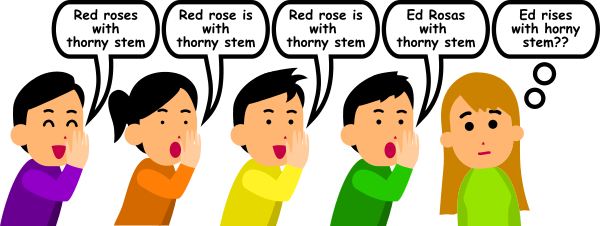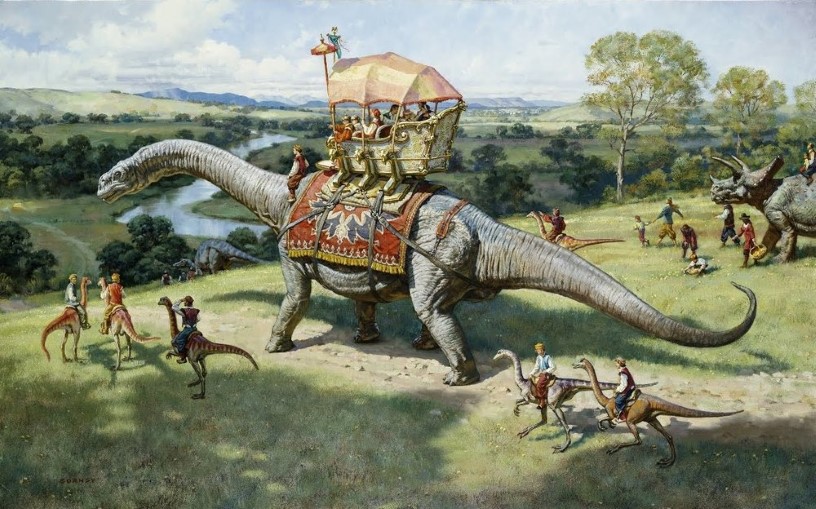— How do we know that chimpanzees and humans are related?
— What does a children’s game have to do with evolution?
— How do transitional fossils prove common ancestry?
A wise man once said: “If you want to understand how birds fly, you should study planes.” So to understand how living things evolve, we should look at other things that evolve.
Remember the broken telephone game? Where the players stand in line and whisper a sentence from ear to ear – and as it’s being passed around, it becomes cumulatively distorted:

Since our hearing and memory are imperfect, the distortion is inevitable. From time to time, little mistakes will be made. And as the game goes on, the mistakes will accumulate and eventually add up to an all-new message.
Try playing it with friends — see how it works.
Similarly, our genetic code is a message. It’s a three-billion-long sequence of four “letters”.

For millions of years, this message has been repeatedly copied and passed from generation to generation. The DNA replication and reparation machinery is as prone to mistakes same as a bunch of kids whispering to each other. It’s called mutations: accidental errors in the genetic sequence.
The accumulation of such errors via sequential passing of information is the essence of evolution.
Q: How is it even possible that humans and chimpanzees are related?
For illustrative purposes, let’s play the game with numbers instead of sentences:

A message is a sequence made of a fixed set of “letters” (digits from 0 to 9). They can come in any combination or order, and any possible sequence is allowed as long as it’s made of those letters only – which is similar to how the genetic code works. And just like the genetic code, a message can be subject to the following types of errors:
- Deletions (a player accidentally skips a digit)
- Insertions (a player accidentally inserts an extra digit)
- Substitutions (a player accidentally mistakes one digit for another)
- Translocations (a player accidentally says digits in the wrong order)
- Duplications (a player accidentally repeats the same digit twice)
Now a question: if the game went on and on, what digit sequences would it be possible to produce out of the original sequence?
And the answer is: any digit sequence!
- Is 54731897 derivable from 54231367? Absolutely!
- Is 6662295 derivable from 238431085? Sure!
Out of any numerical sequence, you can get any other numerical sequence through deletions, insertions and substitutions – the telephone game is the ultimate number evolver.
There are, however, sequences that can never evolve. The game below, for example, is clearly fake:

This round is broken: there is no way you can make a phrase out of a digit sequence when the rules were clear that only digits are allowed.
Now let’s take a look at a chimp’s genome. Perhaps it’s somehow non-derivable from our DNA? Perhaps it includes some letters that are non-existent in our genetic code?
Nope. A chimp’s genome is a sequence of the same four letters, only a slightly different sequence: around 98% of our DNA is the same, and the rest 2% is derivable through deletions, insertions and substitutions. There’s literally nothing that stops chimps and humans from coming from a common ancestor, or even humans evolving directly into chimps (that’s not how it happened of course, but still).
In fact, the genomes of all organisms on Earth are mutually derivable from each other.
Q: Okay, human genome is indeed derivable from chimp’s, but does it prove that we are indeed related? You said yourself that humans could theoretically evolve into chimps, but that’s not what happened — so maybe our common ancestor also could happen, but never did?
Proving that something has happened is harder than proving that something could happen — but a little detective work works wonders. Compare the two games:


Neither of them breaks the rules – both final sequences could derive from the original sequence. However, the second game, although theoretically possible, looks very unlikely. If a million players played it, then sure. But seven players, and such a drastic change — doesn’t look right.
But let’s be more specific: Why exactly do we doubt it, and why wouldn’t we doubt it if there were millions of players instead of seven?
The answer: It all has to do with the expected rate of errors.
In the first game, the final sequence is merely two deletions and one substitution away from the original one. But in the second, we are talking about dozens of changes — or even hundreds.
Now, if we watch and analyze hundreds of games, we’ll notice that there is the rate at which mistakes are made. Many players don’t make mistakes. Some players make one mistake. Few players make two. Let’s just assume that the average is around 0.5 mistakes per player. Given this rate, three mistakes fit well into seven-player-long chain. Hundred mistakes don’t – not even remotely. Hence the second game is fake.
We could do the same math for human evolution. Firstly, we must estimate the mutation rate in humans: take a newborn, read its genome, wait for it to grow up and reproduce, read the genome of the offspring, and count how many letters have changed. If we repeat it with hundreds of babies, we’ll learn that the average mutation rate is around 130 “letters” per generation.
Using this rate, we can estimate that the human and chimp genomes converge at around 4–8 million years in the past.
Now let’s take a look at the fossil record from that time — what a hell was going on back then? Maybe that’s when humans were still coexisting with dinosaurs?

© James Gurney
Or maybe that’s when the first vertebrates have just left water?

© Zina Deretsky/National Science Foundation
But no. No, no, no. The fossil record from those times is rich with primates that have intermediate human-chimp morphology.

Ouranopithecus

Ardipithecus
Coincidence? Perhaps.
There’s another test we can do: we ask the “intermediate” players for their numbers, and see whether what they say fits the whole picture:


In the first game, we can witness the gradual transition and slow accumulation of change — evolution in action. But in the second case, there isn’t even a sign of those three 8’s: we could tell that the second game is fake, but now we’re adamant.
So what about the intermediate “players” of the human-chimp evolution? What’s the fossil record of human evolution like — the first game, or the second?
I wanted to make this reveal as dramatic as possible — but I guess everyone already knows what the answer’s gonna be:

© Smithsonian Institution
We have hundreds of transition forms from an ape to a human — hundreds (!), and every one of them fits exactly where it should both in time and geography. It’s a neat, perfect line.
Not only that, but we have the same chain of transition fossils for the entire animal kingdom: we’ve never found fossil rabbits from Cambrian, nor reptiles before first amphibians, nor modern humans from the age of dinosaurs. The biological evolution really is one big broken telephone game. And it doesn’t cheat.
So, the question comes down to these points:
- Chimps and humans absolutely and 100% can come from a common ancestor — and no natural law prevents it;
- There are many transitional fossils that come in perfect order and show transition;
- That transition chain perfectly matches the expected rate of genome change independently estimated by geneticists;
- There’s no better alternative anyway.

Incomplete list of transition fossils in human evolution (Wikipedia)

So telephone game, hence chimps became people? That your argument??